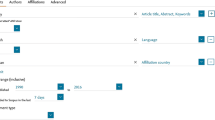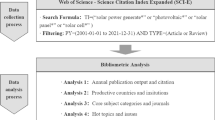Abstract
This paper analyses the following seven sub-fields of Sustainable Energy Research with respect to the influence of proceedings papers on citation patterns across citing and cited document types, overall sub-field and document type impacts and citedness: the Wind Power, Renewable Energy, Solar and Wave Energy, Geo-thermal, Bio-fuel and Bio-mass energy sub-fields. The analyses cover peer reviewed research and review articles as well as two kinds of proceeding papers from conferences published 2005–2009 in (a) book series or volumes and (b) special journal issues excluding meeting abstracts cited 2005–2011 through Web of Science. Central findings are: The distribution across document types of cited versus citing documents is highly asymmetric. Predominantly proceedings papers from both proceeding volumes as well as published in journals cite research articles (60–76 %). Largely, journal-based proceedings papers are cited rather than papers published in book series or volumes and have field impacts corresponding to research articles. With decreasing proceedings paper dominance in research fields the ratio of proceeding paper volumes over journal-based proceedings papers decreases significantly and the percentage of proceedings papers in journals citing journal-based proceedings papers over all publications citing journal-based proceedings papers decreases significantly (from 26.3 % in Wind Power to 4 % in Bio Fuel). Further, the segment of all kinds of proceedings papers (the combined proceedings paper types) citing all proceedings papers over all publications citing all kinds of proceedings papers decreases significantly (from 36.1 % in Wind Power to 11.3 % in Bio Fuel). Simultaneously the field citedness increases across the seven research fields. The distribution of citations from review articles shows that novel knowledge essentially derives directly from research articles (53–72 %)—to a much less extent from proceedings publications published in journals (9–13 %).



Similar content being viewed by others
Notes
In the remaining of the paper the notion ‘proceeding papers’ excludes the WoS document category ‘Meeting abstracts’.
Example of search profile for wind power: TS = (“wind power” OR “wind turbine*” OR “wind energy*” OR “wind farm*” OR “wind generation” OR “wind systems”) AND PY = (2005–2009). Refined by: document types = (proceedings paper or article or review) and [excluding] Web of Science categories = (astronomy astrophysics).
CV signifies the critical value at a given p value and degree of freedom.
Excluding the recent addition of book citation indexing.
References
Bourke, P., & Butler, L. (1996). Publication types, citations rates and evaluation. Scientometrics, 37(3), 473–494.
Butler, L., & McAllister, I. (2009). Evaluating university research performance using metrics. European Political Science, 10, 44–58.
Butler, L., & Visser, M. S. (2006). Extending citation analysis to non-source items. Scientometrics, 66(10), 327–343.
He, Y., & Guan, J. C. (2008). Contribution of Chinese publications in computer science: A case study on LNCS. Scientometrics, 75(28), 519–534.
Ingwersen, P., & Larsen, B. (2014). Influence of a performance indicator on Danish research production and citation impact 2000–12. Scientometrics,. doi:10.1007/s11192-014-1291-x.
Ingwersen, P., Larsen1, B., Garcia-Zorita, J. C., Serrano-López, A. E., & Sanz-Casado, E. (2013). Contribution and influence of proceedings papers to citation impact in seven conference and journal-driven sub-fields of energy research 2005–11. In: Proceedings of the 14th Conference of the International Society of Scientometrics and Informetrics, Vienna, August 2013 (p. 418–425).
Martins, W. S., Goncalves, M. A., Laender, A. H. F., & Ziviani, N. (2010). Assessing the quality of scientific conferences based on bibliographic citations. Scientometrics, 83(19), 133–155.
Meyer, D., Zeileis, A., & Hornik, K. (2012). vcd: visualizing categorical data. R package version 1.2-13.
Mutz, R., Bornmann, L., & Daniel, H.-D. (2013). Types of research output profiles: a multilevel latent class analysis of the Austrian Science Fund’s final project report data. Research Evaluation, 22(2), 118–133.
Sanz-Casado, E., Garcia-Zorita, J. C., Serrano-Lopez, A. E., Larsen, B., & Ingwersen, P. (2013). Renewable energy research 1995–2009: a case study of wind power research in EU, Spain, Germany and Denmark. Scientometrics, 95(1), 197–224.
Thomson-Reuters. ISI. http://researchanalytics.thomsonreuters.com/essays/cpciessay/. Accessed 19 May 2014.
Wainer, J., de Oliveira, H. P., & Anido, R. (2011). Patterns of bibliographic references in the ACM published papers. Information Processing and Management, 47(13), 135–142.
Waltman, L., Calero-Medina, C., Kosten, J., Noyons, E. C. M., Tijssen, R. J. W., van Eck, N. J., et al. (2012). The Leiden ranking 011/2012: Data collection, indicators, and interpretation. Journal of the American Society for Information Science and Technology, 63(12), 2419–2432. doi:10.1002/asi.22708.
Acknowledgments
This research was funded by the Spanish Ministry of Economy and Competitiveness under the project CSO2010-21759-C02-01 titled ‘‘Análisis de las capacidades científicas y tecnológicas de la eco-economìa en España a partir de indicadores cuantitativos y cualitativos de I + D + i” (Analysis of scientific and technological capacities of Eco-economy in Spain, throughout I + D + i quantitative and qualitative indicators), and by Carlos III University of Madrid-Banco de Santander Chairs of Excellence Program for 2011/2012 academic year. A shorter demonstration of some aspects of the analyses was presented in Ingwersen et al. 2013).
Author information
Authors and Affiliations
Corresponding author
Appendices
Appendix A
Annual distribution of published proceedings papers in the seven energy research fields (WoS, January 2014).
PP in vol. | Wind power | Renewable energy | Wave energy | Solar energy | Geo-thermal | Bio mass | Bio fuel |
|---|---|---|---|---|---|---|---|
2005 | 239 | 165 | 70 | 769 | 39 | 62 | 88 |
2006 | 538 | 358 | 64 | 1,033 | 70 | 69 | 101 |
2007 | 903 | 574 | 76 | 1,193 | 75 | 91 | 131 |
2008 | 979 | 673 | 109 | 1,318 | 104 | 104 | 252 |
2009 | 1,522 | 1,074 | 140 | 1,698 | 119 | 208 | 419 |
Total | 4,181 | 2,844 | 459 | 6,011 | 407 | 534 | 991 |
PP in jnls. | Wind power | Renewable energy | Wave energy | Solar energy | Geo-thermal | Bio mass | Bio fuel |
|---|---|---|---|---|---|---|---|
2005 | 53 | 71 | 10 | 604 | 53 | 55 | 95 |
2006 | 84 | 101 | 22 | 751 | 32 | 65 | 93 |
2007 | 61 | 105 | 20 | 514 | 37 | 71 | 151 |
2008 | 60 | 114 | 12 | 580 | 47 | 79 | 127 |
2009 | 47 | 102 | 32 | 613 | 30 | 74 | 154 |
Total | 305 | 493 | 96 | 3,062 | 199 | 344 | 620 |
Appendix B
Pearson’s Residuals for cells in Tables 3, 4, and 5 in the seven energy research fields.
r_a: cited research article; re_a: cited review article; c_a: citing research article; c_pr_v: citing proc. papers in volumes; c_pr_j: citing proc. papers in journals; c_re: citing review articles
c_a | c_pr_v | c_pr_j | c_re | |
|---|---|---|---|---|
Pearson’s residuals: wind power | ||||
r_a | 1.4 | 1.9 | −3.0 | −5.5 |
PP_vol | −5.7 | 11.5 | −1.2 | −4.1 |
PP_j | −0.9 | 0.3 | 7.1 | −3.2 |
re_a | 0.9 | −10.2 | −0.6 | 17.4 |
Pearson’s residuals: renewable energy research | ||||
r_a | 2.8 | −0.1 | −3.4 | −5.0 |
PP_vol | −8.1 | 23.7 | 1.0 | −3.8 |
PP_j | −4.3 | 5.4 | 10.7 | −0.8 |
re_a | 0.5 | −9.0 | −2.5 | 9.3 |
Pearson’s residuals: wave energy research | ||||
r_a | 1.8 | −2.5 | −0.9 | −2.3 |
PP vol | −2.6 | 5.4 | 1.1 | 1.2 |
PP_j | −2.3 | 4.1 | 2.6 | 0.3 |
re a | −2.5 | 0.9 | −0.8 | 8.9 |
Pearson’s residuals: solar energy | ||||
r_a | 5.7 | −2.5 | −8.7 | −10.0 |
PP_vol | −13.5 | 41.5 | 5.7 | −1.9 |
PP_j | −14.7 | 21.1 | 37.9 | −4.0 |
re_a | 3.3 | −21.1 | −13.9 | 23.4 |
Pearson’s residuals: geo−thermal energy | ||||
r_a | 3.0 | −2.3 | −3.7 | −3.9 |
PP_vol | −1.2 | 6.4 | −0.2 | −1.0 |
PP_j | −2.4 | 1.3 | 9.0 | −0.7 |
re_a | −4.0 | 1.9 | 0.4 | 9.0 |
Pearson’s residuals: bio−mass | ||||
r_a | 3.9 | −2.4 | −4.1 | −6.5 |
PP_vol | −2.9 | 16.6 | 2.1 | −2.6 |
PP_j | −3.2 | 3.6 | 9.5 | 1.0 |
re_a | −4.9 | 0.0 | 1.1 | 12.1 |
Pearson’s residuals: bio−fuel | ||||
r_a | 4.0 | 0.9 | −1.2 | −10.8 |
PP_vol | −4.8 | 21.5 | 2.1 | −0.8 |
PP_j | −4.2 | 0.8 | 9.9 | 4.9 |
re_a | −2.7 | −4.2 | −4.3 | 12.5 |
Rights and permissions
About this article
Cite this article
Ingwersen, P., Larsen, B., Carlos Garcia-Zorita, J. et al. Influence of proceedings papers on citation impact in seven sub-fields of sustainable energy research 2005–2011. Scientometrics 101, 1273–1292 (2014). https://doi.org/10.1007/s11192-014-1335-2
Received:
Published:
Issue Date:
DOI: https://doi.org/10.1007/s11192-014-1335-2
Keywords
- Document types
- Proceedings papers
- Research articles
- Review articles
- Citation impact
- Citedness
- Sustainable energy research
- Renewable resources




